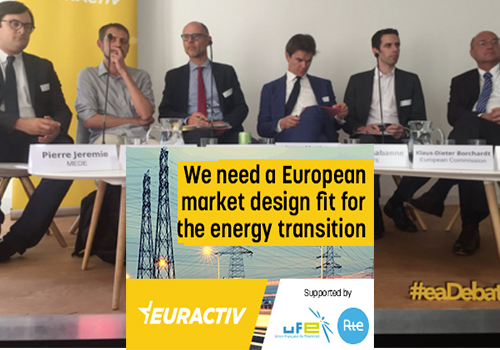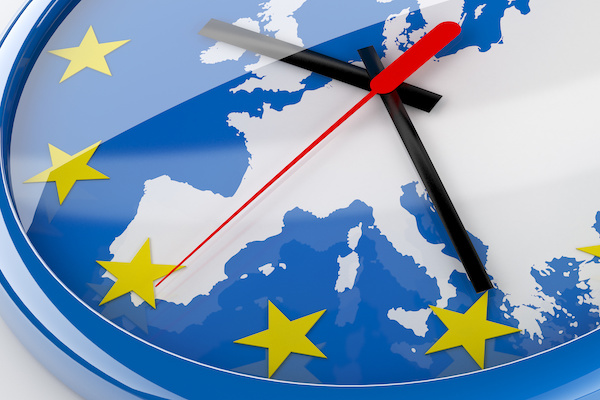10 October 2018
The European electricity sector needs capacity mechanisms!


As negotiations on the electricity market reform are in full swing, the European media Euractiv, with the support of UFE and RTE, organised on September 25th a conference in Brussels on the role of capacity mechanisms in the energy transition. As one of the most political topics of the ongoing discussions on the “Clean Energy for All Europeans” package, capacity mechanisms are instruments that value the availability of generation capacities and demand side response on the market and aim at ensuring security of supply for consumers whatever the circumstances. However, the outcome of the discussions on this subject remains uncertain. UFE comes back to this major challenge of the reform of the electricity market in Europe.
The stakes are high: in a context of energy transition, market rules must facilitate the integration of renewable energy sources, enable consumers to be more active in managing their consumption and ensure security of supply at the lowest cost for citizens.
Two conflicting market approaches
However, as Klaus-Dieter Borchardt, Director for the Internal Energy Market at the European Commission, pointed out during the conference, there are two opposing visions on the design of tomorrow’s electricity market. On the one hand, the advocates of an “energy-only” approach consider that the market alone can ensure security of supply and only consider these mechanisms, assimilated to public intervention, as a last resort. Nevertheless, and as revealed by the study conducted in 2014 by UFE and its German counterpart BDEW, the energy market alone does not provide the necessary long-term investment signals to ensure the availability of generation capacities in the event of a peak in electricity consumption, or to unleash the potential of demand side response by market players. Defended by the Council of the European Union, and supported by the French and European electricity industry, the second vision therefore defends capacity mechanisms as a complement, and not as an alternative, to the reform of short-term markets.
A safety net for the energy transition…
The example of Belgium is meaningful here. James Matthys-Donnadieu, Head of Elia’s Market Development Department, pointed out that by 2025, Belgium will lack 6 GW of capacity to guarantee its electricity supply, in particular due to the closure of its nuclear power plants. However, according to a report published by Elia in 2017, even with the necessary reforms and an ambitious policy to develop renewables, an “energy-only” market will not fill all the missing capacities: 2 GW would still be necessary, leading to a sharp increase in electricity prices for consumers! By guaranteeing the necessary visibility for investors, a capacity market would, according to Mr Matthys-Donnadieu, ensure security of supply in Belgium.
Moreover, and the French case is a good example, a capacity mechanism is part and parcel of the energy transition. According to a study published by RTE and presented by Colas Chabanne during the conference, 1.7 GW of demand side response capacity was certified over the first year of auction of the capacity mechanism, thus contributing to the development of flexibility to cope with a growing share of intermittent energy. As for the question of the costs of such a mechanism, raised in particular by MEP Florent Marcellesi (Greens, ES), RTE’s report shows that the French mechanism could unlock several hundred million euros per year of welfare that could be allocated to other policies.
…which requires an appropriate European regulatory framework
Nevertheless, in view of the diversity of existing mechanisms, Christof Schoser, Deputy Head of Unit in DG Competition, recalls that common rules, established at European level and applicable to all types of mechanisms, are necessary.
On the one hand, capacity mechanisms must meet several criteria, as listed by the European Commission in the conclusions of its sector inquiry published in 2016. Well-designed mechanisms must be market-based, technologically neutral, and allow for the participation of cross-border capacity. Pierre Jérémie, Head of the Market Office at the French Energy Ministry (DGEC), stressed that the French mechanism, approved by the Commission in 2017, meets all these criteria, remunerating each technology up to its contribution to security of supply. He also announced that cross-border participation will be possible at the end of the year.
On the other hand, each situation has its own mechanism: while strategic reserves can be a temporary solution to address short-term adequacy issues, well-designed capacity markets can address a structural capacity need. Christof Schoser therefore stresses that it is not desirable to favour one type of mechanism over another, but that, on the contrary, the same rules should apply to all these tools.
Security of supply, a responsibility borne by Member States
Even more than the design of these mechanisms, the current reform, as proposed by the European Commission, requires ENTSO-E to carry out each year an adequacy assessment at the European level that would allow the implementation of capacity mechanisms by Member States. However, ENTSO-E stated that it was not able to carry out a study as detailed as the national assessments, and, as Pierre Jérémie pointed out, Member States are ultimately responsible for ensuring security of supply to their citizens. While the decision to set up a capacity mechanism may be based on complementary studies carried out at national, regional and European levels, the final decision must be taken by Member States.
Negotiations on this subject have just begun in trialogues and will continue in the coming months, as the Austrian Presidency has announced to be committed to reaching an agreement before the end of the year. Capacity mechanisms have an important role to play in organising tomorrow’s electricity market and in giving visibility to investments and economic actors. European decision-makers therefore have a responsibility to ensure that the energy transition does not take place at the expense of electricity supply.
Find out more
02 June 2020
“Long live Europe”: it’s time for Europe!
25 February 2020
Brexit: love last 47 years


About us
The Union of the French Electricity Industry is the trade association of the French electricity sector. We bring together companies from the whole value chain of the electricity industry.
Find out more









